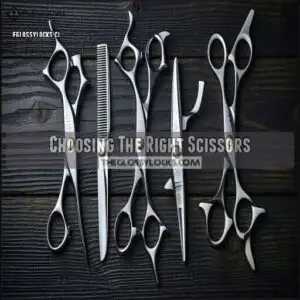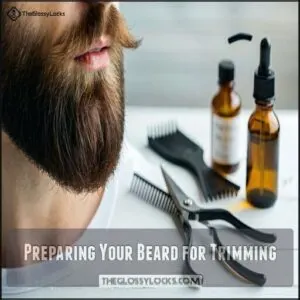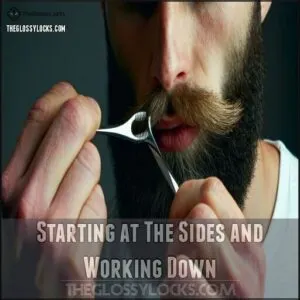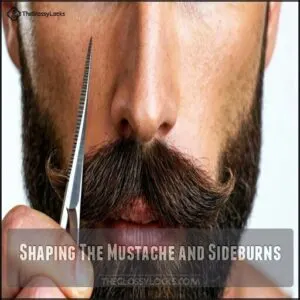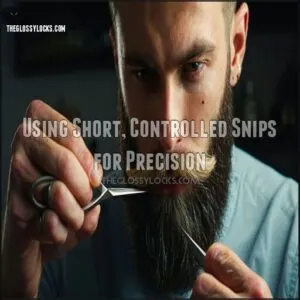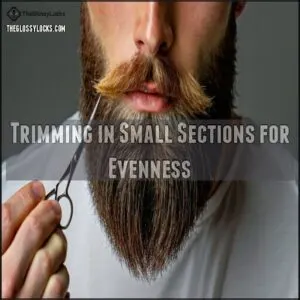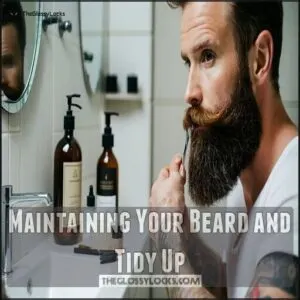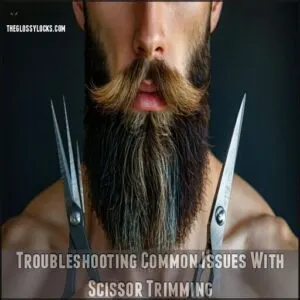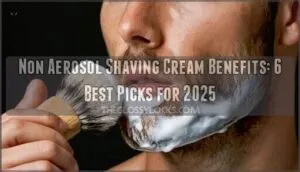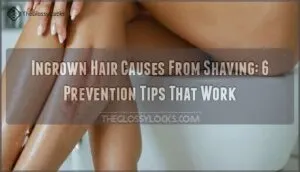This site is supported by our readers. We may earn a commission, at no cost to you, if you purchase through links.
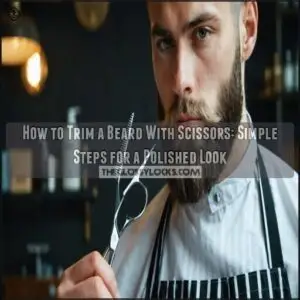 To trim a beard with scissors, start by washing and drying your beard; a clean beard is easier to manage.
To trim a beard with scissors, start by washing and drying your beard; a clean beard is easier to manage.
Use a comb to detangle and reveal your beard’s natural shape—this helps you spot uneven areas.
Begin at the sides, cutting a little at a time with small, controlled snips.
Work your way down to the chin and neck, trimming in layers to maintain evenness.
For the mustache, comb it downward and trim just above your lip.
Always check your progress in a well-lit mirror at different angles for symmetry.
Mastering scissors takes practice, but the polished results are worth it!
Table Of Contents
- Key Takeaways
- Choosing The Right Scissors
- Preparing Your Beard for Trimming
- Trimming Your Beard With Scissors
- Mastering Scissor Techniques for a Polished Look
- Maintaining Your Beard and Tidy Up
- Troubleshooting Common Issues With Scissor Trimming
- Frequently Asked Questions (FAQs)
- How to trim your beard and neck for a short boxed beard?
- Are beard trimming scissors the same as regular scissors?
- What are the best scissors for a beard & mustache?
- Can you trim a beard with just scissors?
- How do you trim a beard for beginners?
- What is the two finger rule for beard?
- How to set a beard at home without a trimmer?
- What are the best scissors for a beard & mustache?
- Is it OK to trim beard with scissors?
- What not to do when trimming a beard?
- Conclusion
Key Takeaways
- Wash and dry your beard first, then comb to detangle and reveal its natural shape for accurate trimming.
- Use sharp grooming scissors designed for beards and make short, controlled snips for precision.
- Always check symmetry from different angles using good lighting to avoid uneven cuts.
- Apply beard oil or balm after trimming to keep your beard soft, shiny, and well-maintained.
Choosing The Right Scissors
Choosing the right scissors is the first step to ensuring a clean, precise beard trim.
Skip the kitchen shears—professional grooming scissors are designed to give you the control and sharpness needed for a polished look.
Types of Scissors for Beard Trimming
Choosing the perfect beard trimming scissors is like choosing a fine tool for craftsmanship—it’s all about precision and purpose.
The right beard scissors turn grooming into an art, blending precision and purpose for a flawlessly polished look.
With so many types available, finding the right pair for your grooming needs can make all the difference.
Here’s a quick guide to the top contenders:
- Stainless Steel Barber Scissors: Known for sharp blades and durable material, these barber scissors guarantee smooth, clean cuts, making them ideal for detailed beard shaping.
- Compact Mustache Scissors: Designed for tricky spots like your upper lip, their small size offers superior control and maneuverability.
- Versatile Trimming Scissors: A balanced size with ergonomic handles, these scissors are great for everyday grooming and quick touch-ups.
Consider exploring a site that offers beard products for more specialized options.
Remember, the right beard scissors provide control, comfort, and confidence—turning your routine into a polished masterpiece. Choose wisely!
Features to Look for in Scissors
The magic of beard trimming lies in the tools you pick—starting with the best beard scissors. Look for sharp blades to guarantee clean, precise cuts while reducing tugging or irritation. Comfortable handles are a lifesaver if you’ve got a lot to trim.
Check the material—durable, rust-resistant steel keeps your scissors reliable. Smaller scissors are great for precision cutting, while slightly larger ones handle more dense beards.
Want quick tips? Use this table for clarity:
| Feature | Why It Matters | Example Benefit |
|---|---|---|
| Blade Sharpness | Precise, clean edges | Fewer split ends |
| Handle Comfort | Better grip and control | Less hand fatigue |
| Material Durability | Rust resistance | Long-lasting investment |
| Size/Maneuverability | Precision for shaping | Easy scissor beard shaping |
| Point Type | Safer trimming with rounded tips | Prevents accidental nicks |
How to Sharpen and Maintain Scissors
Sharp scissors are like a chef’s knife: they make every cut smooth and precise. Regularly sharpen your beard scissors using a sharpening stone—every few months is a good rule. After sharpening, oil the blades lightly to prevent rust and keep movements friction-free.
Sharp scissors ensure each trim is smooth and precise—regular maintenance keeps them performing like a trusted chef’s knife.
Misaligned blades? Realign them before trimming to avoid uneven cuts. For ideal performance, consider investing in high-quality steel shears designed for lasting sharpness.
Store barber scissors in a dry, protected case to prevent rust or damage. For next-level precision, consider professional servicing occasionally.
- Avoid dull blades ruining your clean lines.
- Shield scissors from moisture to stop rust.
- Check alignment regularly for flawless trims.
Tips for Selecting The Best Scissors for Your Beard
Before you start perfecting your scissor beard technique, picking the right beard trimming tools is key. Quality matters—a lousy pair can leave your beard looking patchy or uneven. Go for professional scissors designed specifically for beards, not kitchen or craft ones.
Focus on blade material like Japanese or German steel. These are ultra-sharp, durable, and offer snag-free cuts. Pay attention to handle comfort, too. Offset handles prevent hand fatigue, helping you maintain precision for longer grooming sessions. As for scissor size, smaller, lightweight options (around 5 inches) give you better control when shaping details like edges or sideburns.
Lastly, keep brand reputation and longevity in mind. Trusted barber scissors brands make all the difference for sharper, more consistent results.
- Look for micro-serrated blades to avoid fuzzy trims.
- Pick adjustable tension scissors to customize your cut.
- Invest in maintenance tools to keep blades sharp and smooth.
Preparing Your Beard for Trimming
Before trimming, make sure your beard is clean, dry, and free of any products. This simple step sets the foundation for a smooth, precise trim and helps you avoid over-cutting.
Washing and Conditioning Your Beard
Caring for your beard begins with a proper wash. Skip the bar soap—grab a quality beard shampoo to keep natural oils intact. Use gentle, circular motions to clean your beard and the skin underneath. Rinse thoroughly with lukewarm water—steer clear of hot water, as it can dry out your beard.
Feeling rough like sandpaper? That’s where beard conditioning saves the day. Apply a softening beard conditioner and let it sit for 2-3 minutes for ultimate hydration and manageability.
Here’s your cheat sheet:
Step Product Benefit
Your beard’s first step to greatness starts here!
Drying and Detangling Your Beard
A well-prepped beard is the foundation of precise trimming. Once your beard is clean, make sure it’s dry and smooth to avoid uneven cuts.
Here’s how to tackle it effectively:
- Towel Drying: Gently pat your beard with a microfiber towel in downward strokes. This keeps frizz minimal while preserving your beard’s natural texture.
- Air Drying: Skip the blow dryer—allow your beard to air dry about 80%. Damaging heat? Not worth it!
- Comb Selection: Start detangling from the bottom using a wide-toothed comb. This helps prevent snagging or breakage.
- Brush Types: Finish by working a boar bristle brush through your beard. It smooths the hairs, leaving a polished look.
- Product Buildup: To prevent tangles or dryness, apply a few drops of beard oil to damp hair for shine and manageability.
A detangled, dry beard guarantees your trimming scissors glide like a pro!
Assessing Your Beard’s Shape and Length
Before reaching for your scissors, take a moment to assess your beard’s shape and length—think of it as planning a blueprint before starting a project.
Standing in front of a mirror, use this step to guarantee your beard trimming aligns perfectly with your facial structure and style goals.
Here’s how to evaluate effectively:
- Check texture variations: Coarser areas might need extra trimming finesse.
- Measure consistency: A comb can reveal uneven lengths.
- Spot growth patterns: Trim along the natural flow for smoother results.
- Note beard density: Fuller sections may require thinning, while sparse spots benefit from subtle shaping.
- Assess symmetry: Balancing both sides is vital for a polished beard shape.
This thoughtful evaluation guarantees you achieve the desired length while maintaining a well-groomed, natural look.
Consistent preparation like this makes mastering beard scissor technique much simpler!
Using a Comb or Brush to Detangle and Style
Detangling your beard is key to mastering precision trims. Use a fine-toothed comb or natural bristle brush to tackle knots and guarantee even strokes. Work gently from the tips upward, following the growth pattern.
A proper comb helps with beard grooming needs.
| Comb Selection | Detangling Techniques | Styling Products |
|---|---|---|
| Fine-toothed comb | Start at tips, move upward | Apply light oil |
| Bristle brushes | Avoid tugging, use gently | Choose non-greasy |
| Durable materials | Focus on symmetry check | Prep for scissors |
Smooth, tangle-free beards make trims easier, aligning with your beard scissor technique.
Trimming Your Beard With Scissors
Trimming your beard with scissors gives you complete control over shape and length, ensuring a clean and polished look.
With the right technique and a steady hand, you can achieve precise results without relying on electric tools.
Starting at The Sides and Working Down
Starting at the sides is where your beard trimming journey begins. Begin near the sideburns, just where they meet your ears. Use beard styling scissors to make Controlled Snips, keeping a Consistent Angle parallel to your face.
There’s no need to rush; patience forms the foundation of great beard symmetry. Work with Comb Guidance to lift small sections, cutting gradually for an even and smooth finish. Feel with your fingers for any bulky patches, gently trimming to achieve harmony.
Good lighting is your best ally—step back and assess your Side Symmetry often.
- Follow your beard’s natural grain: this makes the trim seamless.
- Keep cuts small and precise: it’s always easier to take off a bit more.
- Check both sides frequently: unevenness isn’t stylish.
- Trust high-quality scissors: they’re worth avoiding hair damage.
Take your time—beard perfection is an art.
Trimming The Chin and Neck Area
To tackle the chin and neck area, precision is key. For a clear neckline definition, place your index finger horizontally above your Adam’s apple—this sets your natural trimming guide. With your scissors, trim in small, controlled sections. Keep the skin taut and follow the curve of your neck for smoother results.
When working on the chin shape, comb the beard upwards to spot uneven lengths. Trim gently, keeping the scissors parallel to your skin. This helps achieve a clean, balanced finish, avoiding over-trimming that might disrupt the beard’s natural flow.
The blending techniques where the neck meets the jaw deserve special care. Trim lightly here to maintain symmetry and a natural shift between areas. A mirror can be a lifesaver—check frequently from multiple angles to stay on track.
Crafting well-defined beard edges on your neckline highlights your jawline, giving the entire beard a sharper, polished appearance.
Shaping The Mustache and Sideburns
How do you nail the perfect balance between sharp mustache styles and clean sideburns? Start with your mustache. Comb it upward to reveal uneven lengths, and use precise mustache trimming scissors to snip along your lip line.
Follow your natural curve for a polished, cohesive look—no abrupt angles here. This approach ensures that your mustache complements your overall facial features.
For sideburns, keep your hand steady and trim in short, controlled strokes downward. Align their length with your beard, ensuring facial harmony. Don’t rush—sideburn length requires precision.
Use blending techniques to smooth the shift between beard and sideburns, creating seamless edges. This step is crucial for achieving a clean and well-defined look.
Lastly, stick to a maintenance schedule. Regular upkeep means fewer stragglers and keeps your beard shaping game strong!
Tips for Achieving a Natural Finish
Creating a natural finish with scissors is about achieving subtle blending and edge softening.
After trimming your mustache and sideburns, focus on perfecting the neckline and cheeks for balance.
Follow these steps to master a polished, natural look:
- Trim with the grain of your beard to maintain a consistent length and avoid harsh lines.
- Use point-cutting for smooth shifts between sections, preventing an over-trimmed or uneven appearance.
- Gently taper your jawline and cheeks for a soft, seamless blend.
- Pause often to check symmetry—precision is key!
Mastering Scissor Techniques for a Polished Look
Using the right scissor techniques can make all the difference in achieving a well-groomed, symmetrical beard.
By focusing on precision and checking your progress as you go, you’ll avoid uneven cuts and end up with a polished look.
Using Short, Controlled Snips for Precision
Precision shaping is the secret to outstanding beard trimming.
Use short, controlled snips with your scissors, focusing on incremental trimming to refine your beard’s shape.
Avoid overcutting by working gradually; every small adjustment builds toward a polished look.
Hold the scissors parallel to your face for better control and grip near the pivot for stability—this minimizes missteps.
Trim only dry, detangled hair to prevent uneven cuts, as wet hair stretches unpredictably.
Check your progress often, taking a moment to assess symmetry and refine with gradual refinement.
Think of it like sculpting: each snip subtly enhances the overall appearance.
Tip Why Result
Patience guarantees precision!
Trimming in Small Sections for Evenness
Breaking your beard into smaller sections is the key to even results! Incremental cutting gives you better control and avoids over-trimming.
- Work section by section, starting from one side. Use your comb to guide the scissors for consistent length.
- Trim gradually, focusing on short snips that refine one section before moving to the next.
- Check the edges as you go, ensuring symmetry. Gradual refinement creates a polished finish, even when trimming your beard at home.
Checking Progress From Different Angles
Symmetry assessment is a game-changer in beard trimming. Don’t just trust a straight-on view—angles matter! Use a mirror with good lighting and check your progress from various perspectives to catch inconsistencies.
Here’s your beard symmetry guide:
| Angle | What to Check | Why It Matters |
|---|---|---|
| Front | Overall balance | Guarantees even proportions |
| Side Profile | Consistent shape | Avoids awkward bulges |
| Chin Up | Neckline clarity | Prevents over/under trimming |
| Chin Down | Mustache blend | Maintains fluency of style |
| Multiple Angles | Hidden flaws | Enhances precision and neatness |
Switch angles often; it’s the secret to a consistent shape and avoiding mistakes. For best results, consider using professional grooming scissors.
Making Final Adjustments for Symmetry
Fine-tuning your beard’s symmetry is the final step to nailing that polished look.
Take a moment to assess your work with a mirror usage routine that guarantees visual balance and harmony. Instead of chasing perfection, focus on crafting a balanced, natural appearance.
- Stand back from the mirror and tilt your head at different angles, observing the beard’s alignment with your face.
- Run your hands along the edges to identify stray hairs or uneven spots disrupting the outline.
- Use scissors for subtle tweaks, carefully refining edges to achieve an even beard trim that enhances facial proportions.
With precision, refine edges gradually for a smoother finish!
Maintaining Your Beard and Tidy Up
Keeping your beard neat is all about trimming stray hairs and maintaining its shape with regular touch-ups.
A quick tidy-up paired with a bit of beard oil can keep your facial hair looking sharp and feeling soft.
Trimming Stray Hairs and Split Ends
Even the best beards can be undermined by stray hairs and split ends, so regular upkeep is key.
Start by using a fine-toothed comb to identify stragglers. Comb hair downward, spot the culprits, and snip them using sharp scissors held at a slight 45-degree angle. Take small, precise cuts—think micro beard snipping—to avoid removing too much.
Focus on uneven areas and maintain shape by balancing both sides. Stray hairs love to pop up along the jawline or chin, so inspect carefully.
Trimming frequency every couple of weeks helps prevent splits while keeping your look sharp. Remember, targeted snipping preserves your beard’s natural charm.
A key element is to define the neckline for a cleaner look. Regular beard trimming is essential for staying crisp without overdoing it!
Applying Beard Oil or Balm for Softness and Shine
After trimming stray hairs and split ends, it’s time to bring your beard to life with beard oil or balm. These products nourish and also boost softness, shine, and control, taking your grooming game to a new level.
Warm 2-3 drops of beard oil in your palms, then massage it evenly from roots to tips. For added control and hydration, use a pea-sized amount of beard balm. The balm helps tame wild hairs while locking in moisture, leaving your beard both styled and healthy.
Look for products with natural ingredients like argan or jojoba oils—they hydrate and strengthen without clogging pores. Many users see noticeable beard improvements with consistent oil application.
- Oil application gives deep nourishment and natural shine.
- Balm benefits include long-lasting softness and hold.
- Softness techniques make certain a polished, professional finish.
Pamper your beard—it deserves it!
Using a Mirror With Good Lighting for Visibility
Proper visibility isn’t just nice to have—it’s your secret weapon for a polished trim.
Before picking up your scissors, set up a space where you can see clearly and work confidently.
Start with optimal lighting.
Bright, diffused LEDs are ideal, as they reduce shadows that can hide stray hairs.
Natural light is great, but pair it with consistent LED lighting near your mirror for reliable results.
Pay attention to mirror placement.
Use a wall-mounted mirror at eye level and keep a handheld mirror nearby.
This combo lets you check tricky spots like the neckline or jawline.
Consider magnification options for precision.
A small magnifying mirror is perfect for safely trimming delicate areas, like your mustache.
Remember, avoiding shadows and seeing clearly makes beard trimming with scissors not just effective, but satisfying.
Tips for Regular Touch-Ups and Maintenance
A well-maintained beard starts with a regularity schedule for touch-ups and consistent care.
Use sharp scissors for daily edge tidy work, snipping stray hairs before they get wild. Weekly washing and daily combing help detangle and uncover split ends that need trimming.
Incorporate the scissor over comb technique to refine length evenly and maintain symmetry. After each trim, apply beard oil to condition and enhance shine—this simple oil application keeps your beard soft and manageable.
Regularly check your style from different angles to verify balance. With these beard grooming tips, your look will stay polished and effortless.
Troubleshooting Common Issues With Scissor Trimming
Even with careful trimming, uneven cuts, and patchy areas can sneak up on you, but they’re easy to fix with the right approach.
By understanding common mistakes and fine-tuning your technique, you’ll keep your beard looking sharp and balanced.
Avoiding Uneven Cuts and Patchy Areas
Uneven cuts and patchy areas can throw off your entire beard look, but you can fix them with a little care and patience. Start by working with the beard’s natural growth pattern—maintaining a steady hand at a 45-degree angle guarantees precision. Scissor over comb is your best friend here; it helps guide your scissors for a consistent length.
Great lighting matters, too! A well-lit room or natural daylight helps you spot stray hairs you might miss otherwise. Keep symmetry in check by evaluating progress regularly.
- Hold skin taut for a smoother, even trim.
- Use gradual trimming techniques—small snips win.
- Perform symmetry checks from multiple angles.
Dealing With Split Ends and Breakage
Split ends can mess with your beard’s style, but they’re manageable with the right approach.
First, identify causes—dryness, overbrushing, or improper tools often lead to beard split ends.
Use sharp scissors to trim every 6-8 weeks, snipping slightly above splits to prevent further damage.
Prioritize hydration importance by applying quality beard oil daily to keep hairs soft.
Stick to a gentle grooming routine and reduce stress on hair by patting it dry instead of using heat.
Combine regular trimming frequency, proper product selection, and a balanced diet to protect your beard’s health, keeping it strong and polished.
Overcoming Common Mistakes and Inexperience
Trimming mistakes happen, but careful trimming techniques and patience prevent uneven cuts and patchy areas.
Practice using beard scissors in natural light to see details clearly. Start small—tiny snips avoid over-trimming disasters.
- Snip slowly—rushing causes breakage.
- Focus on sections, not the whole—a steady hand refines technique.
- Accept imperfections—split ends or slips are fixable!
Keep practicing; every trim builds confidence.
Tips for Refining Your Technique Over Time
Refining your beard scissors technique takes time and practice. Trim regularly with a steady hand, focusing on gradual refinement.
Use multiple mirrors to check angles and symmetry, and observe professionals for valuable beard trimming tips. Seek feedback from a barber or friend to improve.
For ideal results, consider trimming with the grain to maintain beard health.
Here’s a quick reference:
| Tip | Benefit | Why It Works |
|---|---|---|
| Practice Regularly | Builds confidence | Precision improves over time |
| Observe Professionals | Learn new techniques | Mimic expert methods |
| Seek Feedback | Spot hidden mistakes | Refines your technique |
Frequently Asked Questions (FAQs)
How to trim your beard and neck for a short boxed beard?
Think of sculpting art—start with a clean, dry beard.
Trim your neckline by shaping a gentle curve below your jawline.
Tidy edges, snip stray hairs, and define symmetry for that sharp, boxed-beard perfection.
Are beard trimming scissors the same as regular scissors?
No, beard trimming scissors aren’t the same as regular scissors.
They’re smaller, sharper, and specifically designed for precision and maneuverability in facial hair trimming, giving you clean, controlled cuts without damaging or pulling your beard.
They provide clean cuts, which is essential for maintaining a well-groomed beard.
What are the best scissors for a beard & mustache?
You’ll want professional-grade beard scissors with sharp, precise blades, a comfortable grip, and a manageable size, around 5 inches.
Avoid kitchen scissors—specialized tools guarantee clean cuts, better control, and a well-groomed, stylish beard.
Can you trim a beard with just scissors?
Ironically, despite all the fancy trimmers out there, scissors alone can absolutely handle beard trimming.
With steady hands, sharp shears, and patience, you’ll sculpt your beard, achieving precision and control no trimmer could rival.
How do you trim a beard for beginners?
Start by washing and drying your beard completely.
Comb it to detangle and define length. Trim gradually using sharp scissors, working in small sections.
Regularly check symmetry, and don’t rush—it’s about precision, not speed!
What is the two finger rule for beard?
The two-finger rule helps you trim your beard evenly by placing two fingers above your Adam’s apple to set your neckline.
Trim below this line for a clean, natural look that frames your face perfectly.
How to set a beard at home without a trimmer?
Use sharp grooming scissors to shape your beard.
Comb it to detangle, clip stray hairs following your desired style, and check symmetry as you go.
Finish with beard oil for softness and a smooth look.
What are the best scissors for a beard & mustache?
Go for professional barber scissors with sharp blades and ergonomic handles for control.
Five-inch shears are ideal, offering precision for shaping.
Avoid kitchen scissors—you’re grooming, not chopping vegetables.
Invest in quality, and trim confidently.
Is it OK to trim beard with scissors?
Think of scissors as your beard’s paintbrush.
Trimming with scissors is totally fine and offers excellent precision.
They’re perfect for shaping, maintaining symmetry, and avoiding over-trimming—just make certain they’re sharp, clean, and specifically designed for grooming!
What not to do when trimming a beard?
Don’t rush or over-trim—you’ll regret it later.
Avoid using dull scissors or cutting a wet beard, as it stretches.
Don’t neglect symmetry or forget to check from multiple angles.
Patience saves your beard’s style!
Conclusion
Ready to elevate your grooming game? Mastering how to trim a beard with scissors takes practice, but the results are undeniably rewarding.
By choosing the right tools, preparing your beard properly, and using small, precise snips, you’ll achieve a polished, symmetrical look that sets you apart.
Remember to check your progress frequently in good lighting and refine your technique over time.
With patience and persistence, scissors can become your go-to tool for a clean, confident style!

